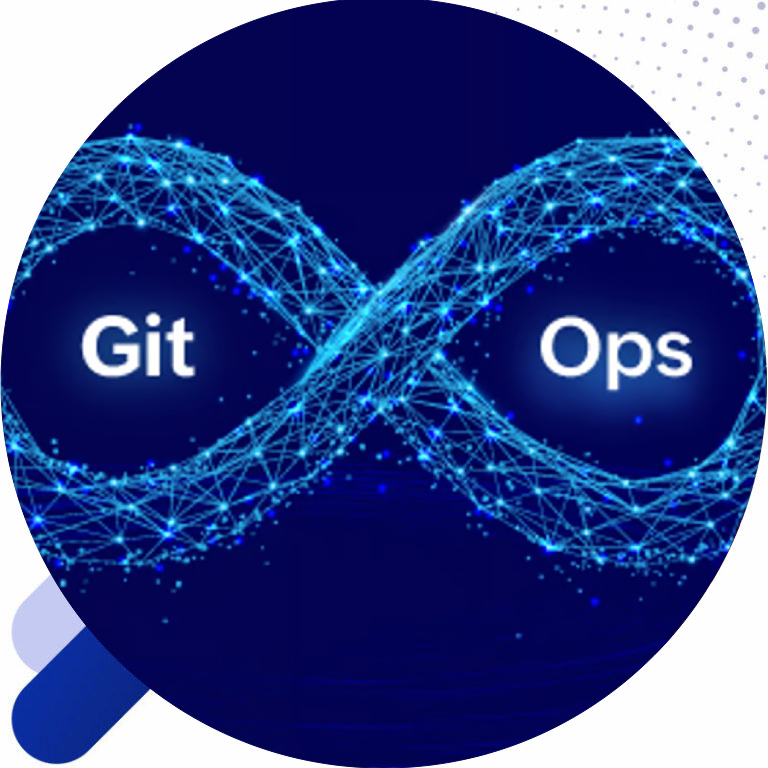What is GitOps?
GitOps is fundamentally about using Git repositories as the single source of truth for declaratively managing infrastructure and application deployments. It integrates tools and practices that leverage familiar Git workflows to provision, manage, and monitor applications and infrastructure. In this model, changes to the desired state of a system are made through Git commits, and automated processes ensure that the actual state of the system converges to the desired state declared in the Git repository.

The Evolution of DevOps and the Emergence of GitOps
DevOps has fundamentally transformed how software is developed, tested, and deployed. It bridges the gap between development and operations teams, fostering a culture of collaboration and shared responsibility. However, as the complexity of systems grows, so does the need for more sophisticated tools and practices. This is where GitOps comes into play.
Key Principles of GitOps

GitOps is built on several core principles that differentiate it from traditional DevOps practices:
Declarative Configuration: All infrastructure and application configurations are expressed in a declarative format. This means that the desired state of the system is described using code, and the system automatically reconciles itself to match this state.
Version Control as Source of Truth: Git repositories serve as the authoritative source for all configurations. Any change to the infrastructure or application is made by committing code to the repository, ensuring a consistent and reproducible state.
Automated Reconciliation: Continuous delivery agents monitor the Git repository for changes and automatically apply them to the infrastructure. This ensures that the actual state of the system always matches the desired state defined in Git.
Immutable Infrastructure: Changes to the infrastructure are made by deploying new configurations rather than modifying existing ones. This immutability reduces the risk of configuration drift and makes rollbacks simpler and more reliable.
Implementing GitOps: A Strategic Approach
Transitioning to a GitOps model requires careful planning and execution. Here are key steps for organizations looking to implement GitOps successfully
Assess Your Current Infrastructure and Workflows
Before introducing GitOps, organizations should assess their existing infrastructure, deployment pipelines, and team workflows. This evaluation will help identify areas for improvement, gaps in processes, and necessary training for team members.
Choose the Right Tools
Selecting appropriate tools is crucial for a successful GitOps implementation. Popular tools include Argo CD, Flux, Jenkins X, and GitLab CI/CD, which facilitate automated deployment, monitoring, and infrastructure management. Organizations should choose tools that align with their tech stack and operational requirements.
Define Declarative Configurations
Teams should begin defining their infrastructure and application configurations in a declarative manner using YAML or similar formats. This involves capturing aspects such as Kubernetes resource specifications, service definitions, and network configurations.
Establish Git Workflows
Defining clear Git workflows is essential for effective collaboration. Organizations should develop guidelines for making changes, conducting pull requests, and managing merge conflicts. This formal structure fosters collaboration while ensuring accountability.
Automate Synchronization and Monitoring
Implement automated processes that continuously monitor the actual state of the infrastructure against the desired state stored in Git. This includes using GitOps tools to detect drift and automatically reconcile differences, ensuring that all changes are reflected accurately across environments.
Training and Awareness
To ensure successful adoption, organizations must invest in training their teams on the new tools, processes, and GitOps methodologies. Providing workshops, documentation, and ongoing support can help overcome the learning curve and internal resistance to change.
The Role of GitOps Consulting
Adopting GitOps can be a transformative journey for organizations, yet it may also present challenges, particularly for those unfamiliar with the methodology and the underlying technologies. This is where GitOps consulting plays a pivotal role.
Expertise and Guidance
GitOps consultants provide specialized expertise in the field, helping organizations navigate the complexities of adoption. They can assess current practices, tailor GitOps strategies to meet unique business requirements, and provide insights on best practices for implementation.
Accelerating Implementation
By leveraging their experience, consultants can accelerate the GitOps implementation process. They can assist in tool selection, configuration management, and pipeline automation, making it easier for organizations to realize the benefits of GitOps in a shorter timeframe.
Change Management Support
GitOps transformation often requires cultural shifts within an organization. Consultants can facilitate change management efforts by fostering collaboration between development, operations, and security teams, ensuring a smooth transition and alignment with organizational goals.
Benefits of GitOps
The adoption of GitOps brings numerous benefits to organizations, making it an attractive proposition for those looking to enhance their DevOps capabilities.
Improved Collaboration
By using Git as the single source of truth, GitOps fosters better collaboration between development and operations teams. Everyone has access to the same information, reducing misunderstandings and enhancing transparency.
Enhanced Security
GitOps promotes a code-centric approach to infrastructure management, which inherently improves security. Changes are tracked, auditable, and can be reviewed before being applied, reducing the risk of unauthorized modifications.
Increased Reliability
The automated reconciliation process ensures that the actual state of the system always matches the desired state. This reduces configuration drift and increases the reliability of deployments.
Faster Recovery
In the event of a failure, GitOps makes it easy to roll back to a previous state. Since all configurations are version-controlled, reverting to a known good state is a simple matter of checking out an earlier commit.
Speak With Expert Engineers.
Contact us by filling in your details, and we’ll get back to you within 24 hours with more information on our next steps

Please fill out the contact form

Call Us
United Kingdom: +44 20 4574 9617

UK Offices
Business Address: 70 White Lion Street, London, N1 9PP
Registered Address: 251 Gray's Inn Road, London, WC1X 8QT
Schedule Appointment
We here to help you 24/7 with experts

